HERE YOU WILL FIND IT!!!
Think,Explore,Discover and meet a new difference....here I simply want to make what you want....
And Thank You Again For Chosing Me
- 622
- 0
- 36
Community
- Followers
- Following
658 items
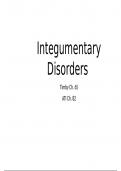
Integumentary Disorders
Integumentary Disorders Timby Ch. 65 ATI Ch. 82 Herpes Zoster (Shingles) • Develops years after a varicella infection • Mostly affects middle age to older adults and immunocompromised persons Pathophysiology • Acute reactivation of varicella –zoster virus • Produces inflammatory responses in the dermatome • If affects the ophthalmic branch of the trigeminal nerve corneal ulcerations can occur. • If affects the vestibulocochlear nerve vertigo and hearing loss ...
- Package deal
- Exam (elaborations)
- • 13 pages •
Integumentary Disorders Timby Ch. 65 ATI Ch. 82 Herpes Zoster (Shingles) • Develops years after a varicella infection • Mostly affects middle age to older adults and immunocompromised persons Pathophysiology • Acute reactivation of varicella –zoster virus • Produces inflammatory responses in the dermatome • If affects the ophthalmic branch of the trigeminal nerve corneal ulcerations can occur. • If affects the vestibulocochlear nerve vertigo and hearing loss ...
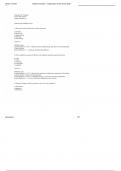
Organization of the Human Body
Organization of the Human Body about:blank 1/57 Package Title: Testbank Course Title: PAP13 Chapter Number: 01 Question type: Multiple Choice 1) This is the study of the functions of body structures. a) anatomy b) physiology c) endocrinology d) histology e) immunology Answer: b Difficulty: Easy Learning Objective 1: LO 1.1 Define anatomy and physiology, and name several subspecialties of these sciences. Section Reference 1: 1.1 Anatomy and Physiology Defined 2) This is defined as ...
- Exam (elaborations)
- • 57 pages •
Organization of the Human Body about:blank 1/57 Package Title: Testbank Course Title: PAP13 Chapter Number: 01 Question type: Multiple Choice 1) This is the study of the functions of body structures. a) anatomy b) physiology c) endocrinology d) histology e) immunology Answer: b Difficulty: Easy Learning Objective 1: LO 1.1 Define anatomy and physiology, and name several subspecialties of these sciences. Section Reference 1: 1.1 Anatomy and Physiology Defined 2) This is defined as ...
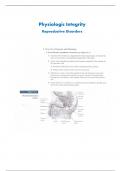
Physiologic Integrity Reproductive Disorder
Physiologic Integrity Reproductive Disorder Physiologic Integrity Reproductive Disorder Physiologic Integrity Reproductive Disorder Physiologic Integrity Reproductive Disorder Physiologic Integrity Reproductive Disorder Physiologic Integrity Reproductive Disorder Physiologic Integrity Reproductive Disorder Physiologic Integrity Reproductive Disorder
- Exam (elaborations)
- • 58 pages •
Physiologic Integrity Reproductive Disorder Physiologic Integrity Reproductive Disorder Physiologic Integrity Reproductive Disorder Physiologic Integrity Reproductive Disorder Physiologic Integrity Reproductive Disorder Physiologic Integrity Reproductive Disorder Physiologic Integrity Reproductive Disorder Physiologic Integrity Reproductive Disorder
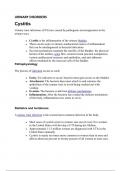
URINARY DISORDERS
URINARY DISORDERS Cystitis Urinary tract infections (UTIs) are caused by pathogenic microorganisms in the urinary tract. ● Cystitis is the inflammation of the urinary bladder. ● There can be acute or chronic nonbacterial causes of inflammation that can be misdiagnosed as bacterial infections. ● Several mechanisms maintain the sterility of the bladder: the physical barrier of the urethra, urine flow, ureterovesical junction competence, various antibacterial enzymes and antibodies, ...
- Exam (elaborations)
- • 14 pages •
URINARY DISORDERS Cystitis Urinary tract infections (UTIs) are caused by pathogenic microorganisms in the urinary tract. ● Cystitis is the inflammation of the urinary bladder. ● There can be acute or chronic nonbacterial causes of inflammation that can be misdiagnosed as bacterial infections. ● Several mechanisms maintain the sterility of the bladder: the physical barrier of the urethra, urine flow, ureterovesical junction competence, various antibacterial enzymes and antibodies, ...
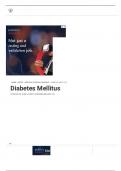
Diabetes Mellitus UPDATED
Diabetes Mellitus UPDATED ON JUNE 5, 2020 BY MARIANNE BELLEZA, R.N. The major sources of the glucose that circulates in the blood are through the absorption of ingested food in the gastrointestinal tract and formation of glucose by the liver from food substances. Diabetes mellitus is a group of metabolic diseases that occurs with increased levels of glucose in the blood. Diabetes mellitus most often results in defects in insulin secretion, insulin action, or even both. Classification T...
- Package deal
- Exam (elaborations)
- • 18 pages •
Diabetes Mellitus UPDATED ON JUNE 5, 2020 BY MARIANNE BELLEZA, R.N. The major sources of the glucose that circulates in the blood are through the absorption of ingested food in the gastrointestinal tract and formation of glucose by the liver from food substances. Diabetes mellitus is a group of metabolic diseases that occurs with increased levels of glucose in the blood. Diabetes mellitus most often results in defects in insulin secretion, insulin action, or even both. Classification T...
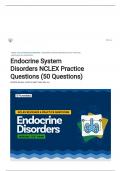
Endocrine System Disorders NCLEX Practice Questions (50 Questions) UPDATED
Endocrine System Disorders NCLEX Practice Questions (50 Questions) UPDATED ON MAY 3, 2022 BY MATT VERA, BSN, R.N. Menu ADVERTISEMENTS Welcome to your NCLEX practice questions quiz for endocrine system disorders. In this nursing test bank, test your nursing competence and knowledge on the nursing care of different endocrine system disorders. Endocrine System Disorders Nursing Test Bank In this section are the NCLEX practice questions for endocrine system disorders. This nursing test ...
- Package deal
- Exam (elaborations)
- • 40 pages •
Endocrine System Disorders NCLEX Practice Questions (50 Questions) UPDATED ON MAY 3, 2022 BY MATT VERA, BSN, R.N. Menu ADVERTISEMENTS Welcome to your NCLEX practice questions quiz for endocrine system disorders. In this nursing test bank, test your nursing competence and knowledge on the nursing care of different endocrine system disorders. Endocrine System Disorders Nursing Test Bank In this section are the NCLEX practice questions for endocrine system disorders. This nursing test ...
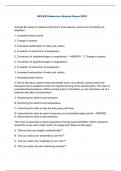
NCLEX Endocrine System Exam 2023
NCLEX Endocrine System Exam 2023 Arrange the series of reactions that occurs when plasma volume and osmolarity are disturbed. 1. Increased blood volume 2. Change in posture 3. Increased reabsorption of water and sodium 4. Formation of active form of angiotensin 5. Conversion of angiotensinogen to angiotensin I - ANSWER 2. Change in posture 5. Conversion of angiotensinogen to angiotensin I 4. Formation of active form of angiotensin 3. Increased reabsorption of water and sodium...
- Package deal
- Exam (elaborations)
- • 28 pages •
NCLEX Endocrine System Exam 2023 Arrange the series of reactions that occurs when plasma volume and osmolarity are disturbed. 1. Increased blood volume 2. Change in posture 3. Increased reabsorption of water and sodium 4. Formation of active form of angiotensin 5. Conversion of angiotensinogen to angiotensin I - ANSWER 2. Change in posture 5. Conversion of angiotensinogen to angiotensin I 4. Formation of active form of angiotensin 3. Increased reabsorption of water and sodium...
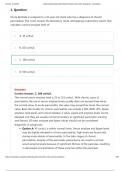
Gastrointestinal Disorders NCLEX Practice Quiz (300+ Questions) - Nurseslabs
Gastrointestinal Disorders NCLEX Practice Quiz (300+ Questions) - Nurseslabs 1. Question Nurse Berlinda is assigned to a 41-year-old client who has a diagnosis of chronic pancreatitis. The nurse reviews the laboratory result, anticipating a laboratory report that indicates a serum amylase level of: A. 45 units/L B. 100 units/L C. 300 units/L D. 500 units/L Incorrect Correct Answer: C. 300 units/L The normal serum amylase level is 25 to 151 units/L. With chronic cases of pancreat...
- Package deal
- Exam (elaborations)
- • 65 pages •
Gastrointestinal Disorders NCLEX Practice Quiz (300+ Questions) - Nurseslabs 1. Question Nurse Berlinda is assigned to a 41-year-old client who has a diagnosis of chronic pancreatitis. The nurse reviews the laboratory result, anticipating a laboratory report that indicates a serum amylase level of: A. 45 units/L B. 100 units/L C. 300 units/L D. 500 units/L Incorrect Correct Answer: C. 300 units/L The normal serum amylase level is 25 to 151 units/L. With chronic cases of pancreat...
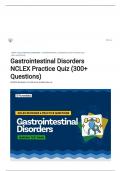
Gastrointestinal Disorders NCLEX Practice Quiz (300+ Questions) UPDATED
Gastrointestinal Disorders NCLEX Practice Quiz (300+ Questions) UPDATED ON MARCH 19, 2022 BY GIL WAYNE, BSN, R.N. Menu ADVERTISEMENTS Welcome to your NCLEX practice questions quiz and reviewer for gastrointestinal disorders. In this nursing test bank, test your competence on the diseases that affect the digestive, biliary, and more. This exam aims to provide a better understanding of the importance of providing patients with appropriate care following gastrointestinal procedures and a...
- Package deal
- Exam (elaborations)
- • 67 pages •
Gastrointestinal Disorders NCLEX Practice Quiz (300+ Questions) UPDATED ON MARCH 19, 2022 BY GIL WAYNE, BSN, R.N. Menu ADVERTISEMENTS Welcome to your NCLEX practice questions quiz and reviewer for gastrointestinal disorders. In this nursing test bank, test your competence on the diseases that affect the digestive, biliary, and more. This exam aims to provide a better understanding of the importance of providing patients with appropriate care following gastrointestinal procedures and a...
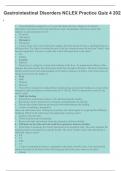
Gastrointestinal Disorders NCLEX Practice Quiz 4
Gastrointestinal Disorders NCLEX Practice Quiz 4 2022 1. Nurse Berlinda is assigned to a 41-year-old client who has a diagnosis of chronic pancreatitis. The nurse reviews the laboratory result, anticipating a laboratory report that indicates a serum amylase level of: a. 45 units/L b. 100 units/L c. 300 units/L d. 500 units/L 2. A male client who is recovering from surgery has been advanced from a clearliquid diet to a full liquid diet. The client is looking forward to the diet chang...
- Package deal
- Exam (elaborations)
- • 72 pages •
Gastrointestinal Disorders NCLEX Practice Quiz 4 2022 1. Nurse Berlinda is assigned to a 41-year-old client who has a diagnosis of chronic pancreatitis. The nurse reviews the laboratory result, anticipating a laboratory report that indicates a serum amylase level of: a. 45 units/L b. 100 units/L c. 300 units/L d. 500 units/L 2. A male client who is recovering from surgery has been advanced from a clearliquid diet to a full liquid diet. The client is looking forward to the diet chang...
